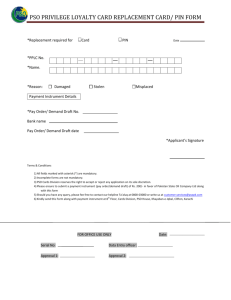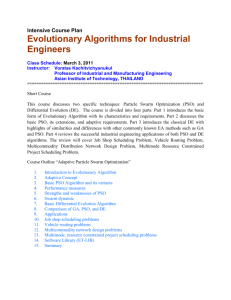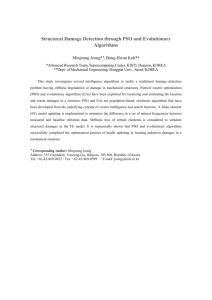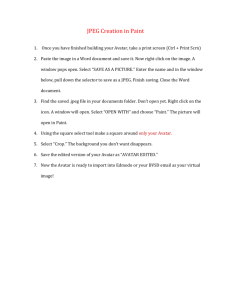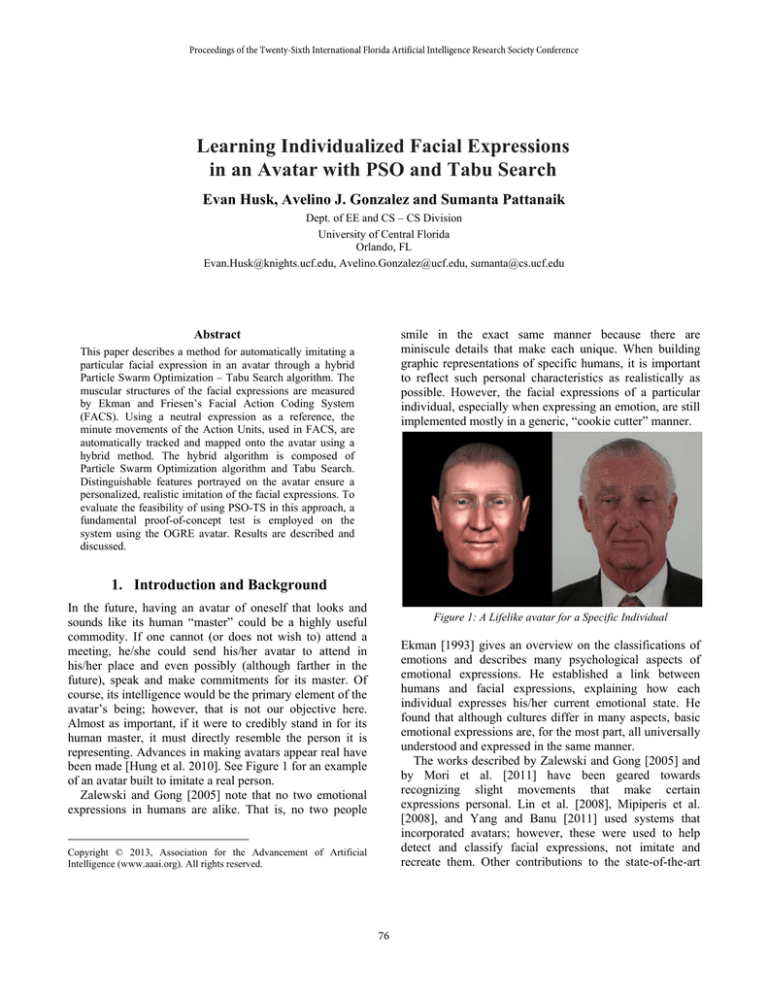
Proceedings of the Twenty-Sixth International Florida Artificial Intelligence Research Society Conference
Learning Individualized Facial Expressions
in an Avatar with PSO and Tabu Search
Evan Husk, Avelino J. Gonzalez and Sumanta Pattanaik
Dept. of EE and CS – CS Division
University of Central Florida
Orlando, FL
Evan.Husk@knights.ucf.edu, Avelino.Gonzalez@ucf.edu, sumanta@cs.ucf.edu
smile in the exact same manner because there are
miniscule details that make each unique. When building
graphic representations of specific humans, it is important
to reflect such personal characteristics as realistically as
possible. However, the facial expressions of a particular
individual, especially when expressing an emotion, are still
implemented mostly in a generic, “cookie cutter” manner.
Abstract
This paper describes a method for automatically imitating a
particular facial expression in an avatar through a hybrid
Particle Swarm Optimization – Tabu Search algorithm. The
muscular structures of the facial expressions are measured
by Ekman and Friesen’s Facial Action Coding System
(FACS). Using a neutral expression as a reference, the
minute movements of the Action Units, used in FACS, are
automatically tracked and mapped onto the avatar using a
hybrid method. The hybrid algorithm is composed of
Particle Swarm Optimization algorithm and Tabu Search.
Distinguishable features portrayed on the avatar ensure a
personalized, realistic imitation of the facial expressions. To
evaluate the feasibility of using PSO-TS in this approach, a
fundamental proof-of-concept test is employed on the
system using the OGRE avatar. Results are described and
discussed.
1. Introduction and Background
In the future, having an avatar of oneself that looks and
sounds like its human “master” could be a highly useful
commodity. If one cannot (or does not wish to) attend a
meeting, he/she could send his/her avatar to attend in
his/her place and even possibly (although farther in the
future), speak and make commitments for its master. Of
course, its intelligence would be the primary element of the
avatar’s being; however, that is not our objective here.
Almost as important, if it were to credibly stand in for its
human master, it must directly resemble the person it is
representing. Advances in making avatars appear real have
been made [Hung et al. 2010]. See Figure 1 for an example
of an avatar built to imitate a real person.
Zalewski and Gong [2005] note that no two emotional
expressions in humans are alike. That is, no two people
Figure 1: A Lifelike avatar for a Specific Individual
Ekman [1993] gives an overview on the classifications of
emotions and describes many psychological aspects of
emotional expressions. He established a link between
humans and facial expressions, explaining how each
individual expresses his/her current emotional state. He
found that although cultures differ in many aspects, basic
emotional expressions are, for the most part, all universally
understood and expressed in the same manner.
The works described by Zalewski and Gong [2005] and
by Mori et al. [2011] have been geared towards
recognizing slight movements that make certain
expressions personal. Lin et al. [2008], Mipiperis et al.
[2008], and Yang and Banu [2011] used systems that
incorporated avatars; however, these were used to help
detect and classify facial expressions, not imitate and
recreate them. Other contributions to the state-of-the-art
Copyright © 2013, Association for the Advancement of Artificial
Intelligence (www.aaai.org). All rights reserved.
76
have been made by Cosker et al. [2011] and Velusami et
al. [2011].
Mori et al. [2011] built a system that incorporates an
avatar that expresses emotions in a natural environment
(i.e. a daily conversation). The authors describe how
emotional facial expressions can be expressed in an avatar
using utterances as an input. That is, the avatar attempts to
take on the emotion expressed in a given sound bite. Their
system adds a personalized aspect in the recreation of the
emotion by considering unique features of the face. To
accomplish this personalization of expressions, the authors
take into account the subtle differences in expressions.
However, significant manual effort is involved in this
manipulation - exactly what we are trying to avoid here.
There is a justified need for personalized expressions in
avatars for numerous applications. This paper presents a
means to apply machine learning techniques to learn how
to express emotions for the avatar simply by learning these
expressions from a photo or video of the person of interest
on a pixel-by-pixel basis. Our objective is to use machine
learning techniques to learn the specific facial expression
on the human master, as recorded on a photograph or video
(photographs were used here), and have the system set the
“slider” values of the working avatar copy. This is to be
done by comparing the images on a pixel-by-pixel basis.
Nevertheless, for reasons of practicality, a lifelike avatar
was not used in this research. Instead, the concept was
tested using the OGRE avatar [OGRE], which is a cartoonlike figure. Nevertheless, its open access and use of sliders
to move the facial muscles provided an excellent
intermediate step to test our algorithms. In our work, two
faces of the OGRE avatar were used, the target copy and
the working copy. The target OGRE face is the desired
look of the avatar. Sliders were used to pre-select the facial
muscles and achieve a unique specific expression. Thus,
the target avatar face can be considered to be the
equivalent of the photograph of a particular human
depicting the desired expression. The working copy is the
one that is to learn how to achieve the look of the target
copy. In our lifelike avatar analogy, the working copy
would be the avatar itself that is to be made to resemble the
human’s expression in the photo (the target copy). See
Figure 2 for a depiction of the OGRE avatar face.
1.1 FACS and Action Units
In order to build a learning algorithm that can do the
above, the muscular structure and features of the avatar’s
face have to be defined in a way that can be measured.
This was done using a form of Ekman and Friesen’s [1978]
Facial Action Coding System (FACS). By designating
Action Units (AUs) involved with the face, the movements
and muscular contractions of the face can be detected and
tracked to help evaluate the slight differences that make an
avatar’s facial expressions unique.
Ekman and Friesen [1978] developed FACS to allow for
a quantitative representation of facial expressions. At the
time, the system was needed to further study emotional
expressions and social interaction between humans
[Donato et al. 1999]. Ekman and Friesen noticed that
certain muscular contractions were the basis of rearranging
the face in a way to express an emotional state. The facial
structure was decomposed into segments to monitor
movements in specific portions of the face. Thus, they
decided to base their system on these muscular
contractions by pinpointing and tracking key locations on
the face that encountered significant changes in the process
of expressing an emotion [Donato et al. 1999].
The specific locations that accurately express the
independent motion of features in the face are more
formally referred to as the Action Units (AUs). The FACS
system incorporates 44 AUs to accurately track and
measure the facial differences encountered when
expressing an emotion [Cosker et al. 2011]. FACS is based
on six basic emotions: anger, disgust, fear, happiness,
sadness, and surprise.
1.2 Mapping Action Units
In order to correctly map the AUs defined in FACS, an
algorithm is typically used that may incorporate machine
learning in the process. The AUs on the OGRE avatar are
controlled by the sliders. Therefore, when the algorithm
manipulates the sliders, the corresponding AUs are also
manipulated. This algorithm allows the mapping process to
take place efficiently and effectively. An algorithm that has
been found to be successful in search and optimization
problems is Particle Swarm Optimization (PSO) [Kennedy
and Eberhart, 1995]. Variations of PSO have been used in
many applications that require an optimal solution [Ghandi
et al. 2009]. In their work, Ghandi et al. make
modifications to incorporate PSO in emotion detection
problems. Another search algorithm used in optimization
problems is Glover’s Tabu Search (TS) [1989, 1990].
Unlike PSO, Tabu Search is a local search algorithm that
takes advantage of a memory structure to log solutions that
were previously visited [Glover, 1989; 1990; Bekrar et al.
2011; Zhang and Wu, 2011]. Because of its local search
characteristics and use of memory, TS has been
“hybridized” with other algorithms to increase its
robustness in certain applications [Thangaraj et al. 2011;
Figure 2: OGRE Tool [OGRE]: Working Avatar face (left) and
Target Avatar face (right)
77
Bekrar et al. 2011; Zhang and Wu, 2011; 2012; Li et al.
2010; Mhamdi et al. 2011]. Because of space limitations,
PSO and TS are not described here but the reader is
referred to their cited original descriptions.
by a random search through the solution space. Once initial
pbests and a global gbest are obtained, the pbests are
passed to Tabu Search to explore the nearby area of the
swarm. TS takes in these pbests and establishes a local
search boundary centered on each pbest. The search
examines the nearby area for a potential better solution. If
a better solution is found, TS returns this updated solution
to PSO. PSO then updates the swarm based on the best
solution found thus far. The pbest and gbest along with the
particles’ velocities and positions are updated. The process
continues in this manner until the stopping criteria is met.
Overall, the combination of PSO and TS joins the strength
of PSO’s global search with TS’s local search to help
diversify the search and overcome PSO’s premature
convergence to poor quality local optima [Zhang and Wu,
2011; Bekrar et al. 2011].
1.3 Objectives of Our Work
Although PSO can successfully search throughout a large
search space and find an optimal solution, it often
prematurely converges toward local optima. This means
the algorithm often is subject to partial optimization.
Instead of finding the global optimal solution, it finds the
local optimal solution within the swarm [Bai, 2010]. A
specific example of this premature convergence is seen in
[Puklavage et al. 2010]. Their mechanism uses PSO to map
the AUs on the OGRE avatar using the PSO mechanism,
which successfully converges to the optimal solution for
the happy, sad, fear, and surprise test faces [Puklavage et
al. 2010]. However, the weakness of PSO was exposed
when their system failed to accurately converge to the
target angry face of the OGRE avatar. In the specific case
of converging to the angry face, PSO continually fails to
find the optimal solution within the search space because it
becomes trapped in a local minimum.
This prior work by Puklavage et al. [2010] attempted to
use the same OGRE avatar (albeit an earlier version) and
PSO to achieve the same objectives described above – that
of using machine learning to automatically learn to
replicate personal facial expressions from photographs of
the avatar’s human counterpart. Our research, therefore, is
a follow up on Puklavage et al’s work in an attempt to
improve upon their results.
Our approach was to make a hybrid PSO-TS learning
algorithm, where the TS part compensated for the
limitations found to exist in the PSO approach to this
problem. Clearly, the hybrid combination of PSO and TS is
not novel, as several others have implemented it as well as
variations thereof. Nevertheless, we describe our
application of this technique to solve a problem that was
not completely solved using PSO by itself.
2 The PSO-TS Hybrid System
Our hybrid PSO-TS algorithm is described in Figure 3.
This hybrid PSO-TS algorithm combines a slightly
modified form of PSO with a standard Tabu Search. The
flowchart of Figure 3 provides a top-level overview of the
architecture of the algorithm. As depicted in the flowchart,
PSO serves as the driving force of the PSO-TS algorithm.
Unlike other models where the search population is
randomly halved and TS and PSO are independently
operated [Zhang and Wu, 2011; 2012], our hybrid PSO-TS
embeds TS within PSO. The diversification of the search
provided by TS helps PSO avoid its limitation of
premature convergence toward local optima. The PSO
algorithm drives the overall search and begins the process
Figure 3: Top Level Flowchart of PSO-TS
3 The OGRE Application
We first describe our use of OGRE as the testbed to test
our algorithm. To do this, we developed the OGRE
Algorithm Comparison Tool (OACT). To begin the
development of OACT, the OGRE Official Demos
Distribution v1.7.0 (Windows) was downloaded [OGRE].
The OGRE face is centered in the middle of the screen
with 18 sliders available in the upper left-hand corner.
Once the “Manual” option is selected, the OGRE face
stops its automated movements and provides the user with
78
ffull control of the facial mussculature of thee OGRE avataar.
T
The
sliders arre individuallly labeled to describe theeir
c
corresponding
a
action.
The overalll architecture of the dow
wnloaded Faciaal
A
Animation
dem
mo was transsferred via JavaScript to a
W
WebGL
applicaation to allow for the same manipulation
m
o
of
thhe OGRE facee via a set of 18
8 sliders. Our OACT
O
providees
a similar layouut to the Facial Animation demo.
d
As in ouur
toool, Puklavagge et al. [20
010] also bassed their PSO
O
m
mechanism
onn the OGRE
E Facial Animation demoo.
H
However,
unlikke their work
k, our OACT is not directlly
e
embedded
in, or
o dependent on
n, the OGRE demo.
d
When develooping OACT, the
t facial moddels and texturees
u
used
in the Facial Animation demo were dirrectly implanteed
inn the WebGL application to ensure the sam
me OGRE avataar
f
face
was used. Unlike the OGRE
O
Facial Animation
A
dem
mo
a the mechannism used by Puklavage
and
P
et al.,
a our tool usees
tw
wo OGRE avaatar faces. Thesse faces are sett in a horizontaal
f
format
to alloow the appliication to proovide real-tim
me
f
feedback
throuugh the expresssions on the OGRE avatarrs.
T layout of our
The
o tool is pro
ovided in Figurre 4 below. Thhe
f
face
on the lefft is the workin
ng face while the face on thhe
r
right
is the targget face. The musculature
m
off the target facce
c be manipulated via the sliders
can
s
on the right
r
side of thhe
toool. There are 19 sliders, bu
ut only 18 of thhem are used to
t
m
manipulate
thee avatar face. The neutral slider
s
under thhe
“
“Expressions”
heading is inccorporated stricctly to resemblle
thhe updated verrsion of the OG
GRE demo, to allow for futurre
im
mprovements of the tool. The
T 18 sliderss can take in a
v
value
between 0 and 1, corrresponding to the intensity of
o
thhe correspondiing expression.
buttonn will run the hybrid
h
PSO-TS
S algorithm. Thhe “STOP”
buttonn immediately halts the process and displayys the best
facial match up to thhat point in thee search. The “Start
“
Tabu
Searchh after iteratioon:” slider is used to actiivate Tabu
Searchh after a speccified number of iterations. The “End
Tabu Search when Fitness
F
<” slideer is used to terrminate the
T
Search onnce a fitness thhreshold, discuussed in the
local Tabu
follow
wing section, is
i reached. Both
B
of these sliders are
onlly applicable too the PSOTS search methood. Again,
b
and
theese additional buttons
slidders are used for testing
purrposes only annd do not
direectly control thhe avatar’s
faccial
structuure.
An
impportant factor considered
whhile developinng OACT
was the search status and
connvergence
feedback.
Onnce either search
s
is
activated,
reaal
time
p
of
feeedback of the progress
thee search is provided
throough the workking avatar
facce. Keeping inn mind that
Figure 5: OAC
CT
the
working facee is on the
Coonvergence Feeddback
leftt and the targett face is on
the right, the avataar faces in Fiigure 5 demonnstrate the
progreession of the search as itt converges toward the
optimal solution. The
T top set off OGRE facess shows a
workinng avatar face that is greatlyy deformed. Att this point,
the seearch has jusst begun andd the algorithhm is just
beginnning to exploree the search sppace. As the seearch finds
better solutions, it coontinually movves toward the target face
as seeen in the midddle faces. Finally, once thhe optimal
solutioon has been found,
f
the woorking and tarrget avatar
faces closely
c
match, as depicted inn the bottom paair of faces.
4
Exp
periments and
a Results
The testing
t
involvved two phasses. We desccribe each
separaately in the folllowing subsecttions.
4.1 Phase
P
I: Estaablishing a Baseline
B
The purpose of Phase I was to esttablish a baseliine for our
t
matched the results obbtained by
PSO-oonly system that
Puklavvage et al. [2010]. This was to preeclude the
possibbility that our specific implementation off PSO, our
use off the OACT, and/or the new
w version of the
t OGRE
avatarr face may haave introducedd experimentaal bias not
reflectted in the workk of Puklavagee et al. It shoulld be noted
that thhe new versionn of OGRE useed in our impleementation
has uppdated glassess that “shade” the eyes. How
wever, this
does not
n affect the comparison
c
of our results beccause none
of thee facial expresssions tested inccorporate the eyes
e
of the
Figuree 4: OGRE Algorrithm Comparisoon Tool
Deviating from
D
m the standard
d layout of thee OGRE demoo,
s
some
instrumennts were added
d to assist in teesting. Placed at
a
thhe top of the OACT
O
are threee buttons and tw
wo sliders. Thhe
“
“Run
PSO” and
a
“Run PSO
O+TABU” buuttons run theeir
r
respective
algoorithms. It sho
ould be noted thhat the modulaar
d
design
of thee hybrid PSO
O-TS algorithhm allows thhe
a
algorithms
to run independeently. Thus, the “Run PSO
O”
b
button
will onnly run PSO and the “Runn PSO-TABU
U”
79
signifi
ficantly vary based
b
on the random initialization of
PSO. These figures clearly shhow that thee PSO-TS
algoritthm convergeed much moore quickly and with
signifi
ficantly less errror than did Puklavage et al’s PSO
implem
mentation.
aavatar. Our verrsion of PSO, called “OACT
T PSO” for lacck
o a better nam
of
me, was run on
o the five facces imitated by
b
P
Puklavage
et all. The results arre shown in Figure 6.
Target facce
Target face
Puklavagee
et al. PSO
O
Pu
uklavage
et al. PSO
OACT PSO
O
PS
SO-TS
Figure 6: Phase I Visuall Results
Figure 7: Phasse II Visual Resuults
It can be seenn that, as in Puklavage et al’s work, thhe
r
rightmost
fourr faces converged successffully. This waas
d
done
in the sam
me number of iterations
i
(2500), and using thhe
s
same
swarm siize (50). Moree importantly, it can be easilly
s
seen
that the leeftmost face, that
t
depicting anger, failed to
t
c
converge,
as inn Puklavage et al’s case, albeeit resulting in a
d
different
expreession altogeth
her. This connfirms that thhe
O
OACT
PSO meeets the baselin
ne requirementts. Nevertheless,
o
one
should noote that the four faces thhat successfullly
c
converged
withh OACT PSO are slightly diifferent than thhe
taarget faces beccause of the diffferent versions of OGRE.
5. Conclusion
In connclusion, the data
d
shows thaat the PSO-TS
S algorithm
repressents a significcant improvement over the eaarlier work
by Puuklavage et al. [2010]. While the PSO-TS algorithm
resulteed in some differences
d
in the faces, thhese were
considdered negligiblle. However, this
t
assumption needs to
be teested in the future withh human subbjects for
confirrmation. The use
u of the OG
GRE avatar reppresents an
interm
mediate step toowards our ultiimate goal of being able
to reprroduce in an avatar
a
the persoonal facial expressions of
speciffic individuals.
4.2 Phase II: PSO-TS Peerformance
This Phase of the testing ev
T
valuated the coore objective of
o
o research. Is the combinaation of PSO with
our
w TS able to
t
o
overcome
the deficiencies
d
exp
perienced by Puklavage
P
et all?
U
Using
OACT and
a applying PSO-TS,
P
the saame five OGR
RE
f
faces
were subjjected to the prrocess of reprooducing the fivve
taarget faces in a pixel-b
by-pixel mannner. Figure 7
g
graphically
deppicts the resultss. It can be seeen that the angrry
f
face
(the left-m
most face in Fig
g. 7) generated by our PSO-T
TS
a
algorithm
clearrly resembles the target anngry face mucch
m
more
closely thhan did Puklavaage et al’s PSO
O.
T graphs in Figure
The
F
8 reflecct data collecteed on the fitnesss
o the OGRE working
of
w
faces computed
c
durinng the executioon
o both algorithhms. The fitness value (0-3) directly reflects
of
thhe pixel-by-piixel differencees between thhe working annd
taarget avatar faces
fa
by calcullating the Mannhattan distancce
b
between
two reeference pointss. Higher fitnesss values reflecct
g
greater
differennces in the two
o faces. It shouuld be noted thaat
thhe initial fitness is dependen
nt on the randoom initializatioon
o the swarm
of
m. Therefore, the initial fitness valuees
PSO‐TS
PSO
Angry
3
Fitness
2
1
0
0
50
100
1
150
Iteratio
on
200
250
PSO‐TS
PSO
Happy
3
Fitness
2
1
0
0
80
50
100
150
Iteratio
on
200
250
PSO‐TS
PSO
Sad
3
Glover, F., “Tabu search: Part I,” ORSA Journal on Computing,
1(3), pp. 190-206, 1989.
Glover, F., “Tabu search: Part II,” ORSA Journal on Computing,
2(1), pp. 4-32, 1990.
Hung. V., Gonzalez, A. J. and DeMara, R. F., “Dialog
Management for Rapid-Prototyping of Speech-Based Training
Agents“, Proceedings of the Interservice/Industry Training
Simulation and Education Conference, Orlando, FL Dec. 2, 2010
Kennedy J. and Eberhart, R. “Particle swarm optimization,”
Proceedings of IEEE International Conference on Neural
Networks, Perth, Australia, pp. 1942-1948, 1995.
Li, J., Pan, Q., Xie, S., Jia, B. and Wang, Y., “A hybrid particle
swarm optimization and tabu search algorithm for flexible jobshop scheduling problem,” International Journal of Computer
Theory and Engineering, 2(2), pp. 189-194, 2010.
Lin, C.J., Chu, C.H., Lee, C.Y. and Huang, Y.T. “2D/3D face
recognition using neural networks based on hybrid taguchiparticle swarm optimization,” Eighth Int’l Conf. on Intelligent
Systems Design and Applications, vol. 2, pp. 307-312, 2008.
Mhamdi, B., Grayaa, K. and Aguili, T. “Hybrid of Particle
Swarm Optimization, Simulated Annealing and Tabu Search for
the Reconstruction of Two-Dimensional Targets from
Laboratory-Controlled Data,” Progress In Electromagnetics
Research B, vol. 28, pp. 1-18, 2011.
Mori H., Oshima K., and Nakamura M., “Generating avatar’s
facial expressions from emotional states in daily conversation,”
IEEE International Conference on Acoustics, Speech and Signal
Processing (ICASSP), pp. 5720-5723, 2011.
Mpiperis, I., Malassiotis, S., Petridis, V. and M. Strintzis, G., “3D
facial expression recognition using swarm intelligence,” IEEE
International Conference on Acoustics, Speech and Signal
Processing, pp. 2133–2136, 2008.
OGRE – Open Source 3D Graphics Engine, 2012,
http://www.ogre3d.org.
Puklavage, C., Pirelas, A.R., Gonzalez, A.J. and Georgiopoulos,
M., “Imitating Personalized Expressions in an Avatar through
Machine Learning”, Florida AI Research Conf., May 2010.
Thangaraj, R., Pant, M., Ajith, A. and Pascal, B., “Particle Swarm
Optimization: Hybridization Perspectives and Experimental
Illustrations,” Applied Mathematics and Computation, 217(12),
pp. 5208-5226, 2011.
Velusamy, S., Kannan, H., Anand, B., Sharma, A. and Navathe,
B., “A method to infer emotions from facial action units,” IEEE
International Conference on Acoustics, Speech and Signal
Processing, pp. 2028-2031, 2011.
Yang S. and Bhanu B., “Facial expression recognition using
emotion avatar image,” IEEE Int’l Conference on Automatic Face
& Gesture Recognition and Workshops, pp. 866-871, 2011.
Zalewski L. and Gong, S. “2D statistical models of facial
expressions for realistic 3D avatar animation,” IEEE Conf. on
Computer Vision and Pattern Recognition, vol. 2, pp. 217-222,
2005.
Zhang Y. and Wu, L., “A Hybrid TS-PSO Optimization
Algorithm,” Journal of Convergence Information Technology,
6(5), pp. 169-174, 2011.
Zhang Y. and Wu, L., “Tabu Search Particle Swarm Optimization
used in Cluster Analysis,” J. of Science, 1(1), pp. 6-12, 2012.
Fitness
2
1
0
0
50
100
150
200
250
Iteration
PSO‐TS
PSO
Scared
3
Fitness
2
1
0
0
50
100
150
200
250
Iteration
PSO‐TS
PSO
Surprised
3
Fitness
2
1
0
0
50
100
150
200
250
Iteration
Figure 8: Convergence Comparison of PSO-TS to
al’s PSO
Puklavage et
6. References
Bai, Q., “Analysis of Particle Swarm Optimization Algorithm,”
Computer and Information Science, 3(1), pp. 180-184, 2010.
Bekrar, A., Chaabane, S., Trentesaux, D., Bornschlegell, A.,
Pelle, J. and Harmand, S., “Hybrid PSO-tabu search for
constrained non-linear optimization problems,” International
Conference on Swarm Intelligence, Cergy, France, 2011.
Cosker, D., Krumhuber, E. and Hilton, A., “FACS valid 3D
dynamic action unit database with applications to 3D dynamic
morphable facial modeling,” IEEE International Conference on
Computer Vision pp. 2296-2303, 2011.
Donato, G., Bartlett, M.S., Hager, J.C., Ekman, P. and Sejnowski
T.J., “Classifying facial actions,” IEEE Trans. on Pattern Anal. &
Machine Intelligence, 21(10), pp. 974-989, 1999
Ekman P. and Friesen, W. “Facial action coding system: A
technique for the measurement of facial movement”. Palo Alto,
CA: Consulting Psychologists Press, 1978.
Ekman, P., “Facial expression and emotion,” The American
Psychological Association, Inc., vol. 48, no. 4, pp. 384-392, 1993.
Ghandi, B.M., Nagarajan, R. and Desa, H., “Particle swarm
optimization algorithm for facial emotion detection,” IEEE Symp.
on Industrial Electronics & Appl., vol. 2, pp. 595-599, 2009.
81

